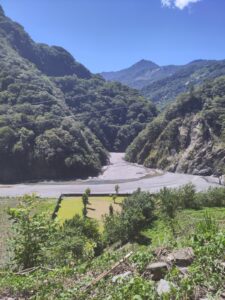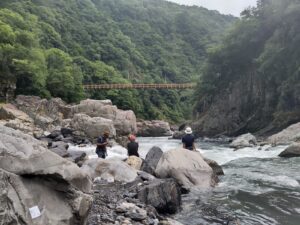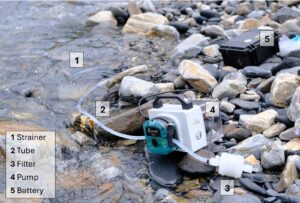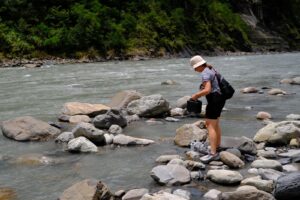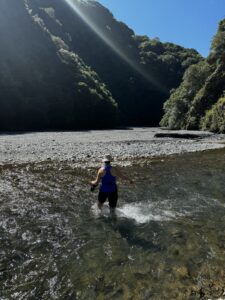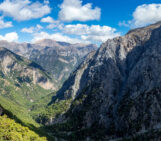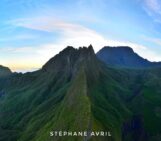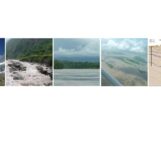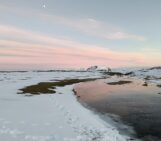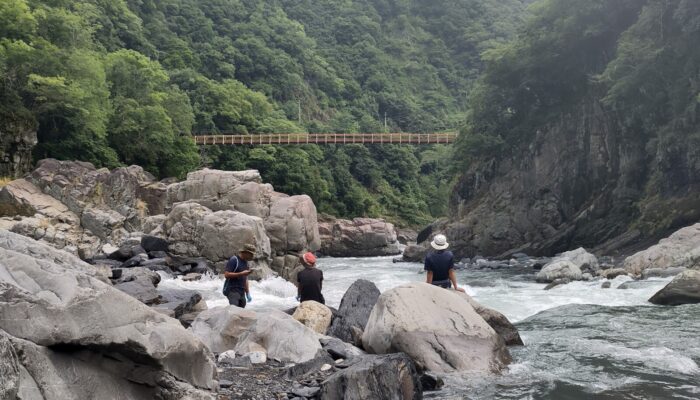
This blog post is part of our series: “Highlights” for which we’re accepting contributions! Please contact one of the GM blog editors, Emily (eb2043@cam.ac.uk) or Emma (elodes@asu.edu), if you’d like to contribute on this topic or others.
by Caro Krug, Doctoral Student, ETH Zurich, Switzerland
Email: cakrug@eaps.ethz.ch
The Formosan landlocked salmon (Oncorhynchus masou formosanus) can only be found in a single stream deep within the mountains of the subtropical island of Taiwan. This species is not only one of the southernmost salmon populations in the world but also the only salmon found at elevations above 1,700 meters. To honour its unique status and emphasize its critically endangered condition, the Taiwanese landlocked salmon is even featured on Taiwan’s 2000-dollar bill (Figure 1). Typically, I would picture salmon swimming through the cold waters of (sub)polar oceans or Alaskan rivers. How, then, did this species arrive in Taiwan? Its ancestors migrated from the Sea of Japan approximately 10 to 80 million years ago. When glaciers retreated, some salmon populations remained in the river’s upper reaches, and through geographic isolation, evolved into the landlocked species we know today.
Another fascinating example of Taiwan’s unique biogeography can be found in the East: around 3 Ma ago, the uplift of the steep Qing-Shui cliff created a geographic barrier that facilitated the evolution of two sister species in the Takydromus lizard complex: one with yellow spots and the other with green. Today, these sister species are direct neighbours, separated only by a 15-meter-wide stream [3].
Both cases vividly illustrate how mountains can influence species distribution: without the cold mountain streams as a refuge, the Formosan landlocked salmon in Taiwan might have gone extinct during warmer periods. Instead, their isolated habitat encouraged adaptation, eventually leading to the evolution of a new species. Similarly, without the Qing-Shui cliff, the lizards might still be a single species.
Globally, mountain regions stand out as extraordinary biodiversity hotspots, and Taiwan is one of them. Islands, due to their relative isolation, generally feature high levels of endemism and have long been recognized as ideal natural laboratories for studying species diversification. Taiwan’s landscape is characterized by steep, densely vegetated mountains throughout most of the eastern region. With ongoing orogenesis and frequent heavy rainfall, Taiwan experiences some of the world’s highest erosion rates and rapid landscape evolution. Its dynamic landscape makes Taiwan an ideal location for studying how mountain building and landscape evolution influence biodiversity. As landscape evolution is often expressed through river network reorganization, aquatic species diversity is expected to show a particularly strong response to mountain formation. For instance, a river capture event could separate two populations of the same species, disrupting gene flow between them.
This summer, I travelled to Taiwan to collect water samples of environmental DNA (eDNA) to characterize the aquatic biodiversity of selected drainage basins. Environmental DNA refers to a mixture of genetic material from various organisms found in environmental samples, such as water, sediment, soil, or air. Plants and animals constantly shed DNA into the environment, in forms such as mucus, saliva, faeces, urine, or pollen. These genetic traces persist in the environment for a limited time; in water, they last from a few hours to several days [4]. In the lab, the DNA is extracted from the samples and analysed using a method called “metabarcoding,” where a specific DNA fragment is targeted and amplified, allowing the identification of DNA fragments by matching them to known species in a database. Ultimately, this process provides a dataset of, for instance, all fish species whose DNA was detected in the sample.
“Sampling for eDNA is easy,” or so I was told repeatedly before the field trip. After this summer, I only partly agree, however, the basic sampling procedure is indeed straightforward: in theory, you could simply collect a bucket of water and take it to the lab. To reduce contamination and increase the yield of target DNA, we used a peristaltic pump to filter approximately 30 litres of water, collecting DNA in the filter (Figure 3). After filtering, a buffer solution is added to prevent DNA degradation.
As so often in fieldwork, things went very differently from what was initially planned: A typhoon hit the island, right during our first week of sampling. Typhoon Gaemi caused severe damage in the East of the island, triggering multiple landslides that blocked major roads. We had to abandon our plan almost entirely and improvise as we went along. Moreover, the sampling setup was particularly challenged by muddy waters: more than once, sediment blocked the tubing, making it expand and expand—until it finally burst! We tried to avoid sampling muddy rivers, however, our efforts were doomed to fail in a rapidly eroding landscape right after the rainy season.
To minimize contamination across sites and with human DNA, we wore new gloves, used a new tube at each location, and carefully cleaned the pump and other equipment with bleach. One time, while we waited, as decontaminated as possible, a man decided to go for a swim about 50 meters upstream from our sampling point. No, he wasn’t just swimming—he was showering! Scrubbing his skin thoroughly, he helped ensure we’d capture some DNA in this sample.
Finally, in the last week of my six-week stay, we successfully collected our final samples. Now, as I am eagerly waiting for the lab results, my curiosity grows each day—and part of me is hoping to find a gap in the data, just for good reason to return to Taiwan!
This field trip would not have been possible without the support of many colleagues and students from Taiwan: I would like to thank Ing for taking care of basically everything, from introducing me to lab work (and carrying out most of it herself), driving to sampling sites, and encouraging me to enjoy early morning hours; Hsi-Cheng and his lab members for hosting me in the lab and providing mental support; Iris and Wallace for joining several multi-day field trips and excellent hobbiting (=selecting the best food); and all the other students who joined the sampling trips and helped in multiple ways.
References
[1] Yan, H. Y., 2000. Threatened fishes of the world: Oncorhynchus masou formosanus. Environmental Biology of Fishes 57, 314.
[2] https://www.banknoteworld.com/taiwan-2-000-yuan-banknote-2001-p-1995-unc.html accessed 04.11.2024
[3] Tseng, S.-P., Wang, C.-J., Li, S.-H., Lin, S.-M., 2015: Within-island speciation with an exceptional case of distinct separation between two sibling lizard species divided by a narrow stream. Molecular Phylogenetics and Evolution 90, 164-175.
[4] Sansom, B. J., Sassoubre, L. M., 2017: Environmental DNA (eDNA) Shedding and Decay Rates to Model Freshwater Mussel eDNA Transport in a River. Environ. Sci. Technol. 51, 14244-14253.


